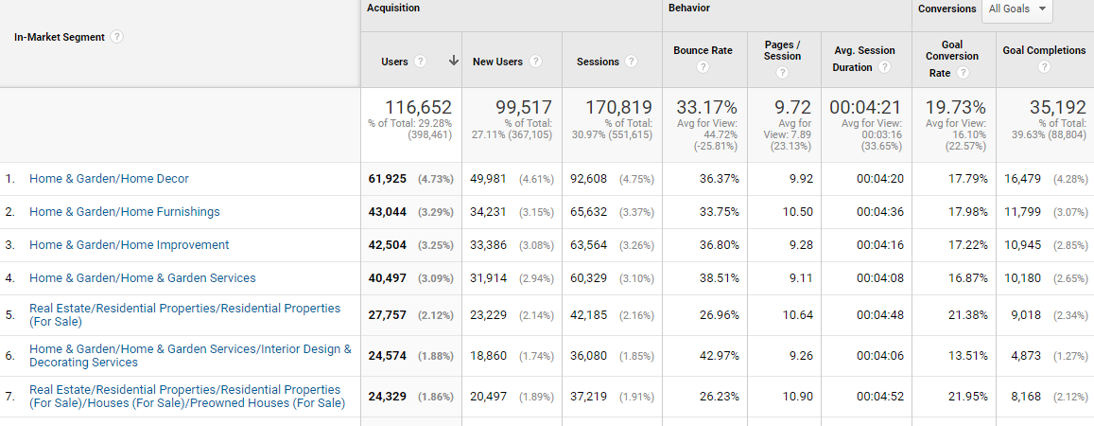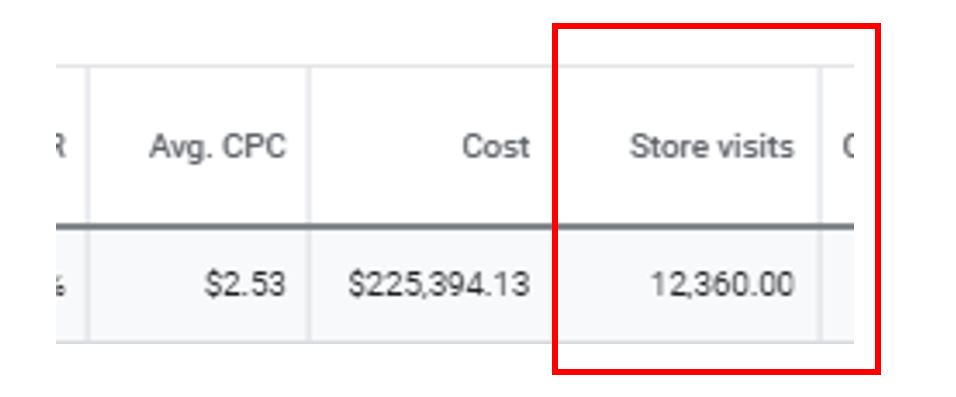If you want your PPC campaigns to remain effective in 2020, you have no choice but to evolve. In some cases, that evolution will mean thinking about things very differently than before.
If your program isn’t in an advanced state already, here are ten tactics you must try this year (in no particular order).
1. Layered Audience: Demographics & Affinity
It’s no secret that a campaign will perform best when you clearly define who it’s meant for.
By using the combined power of Google Ads and Analytics, you’re able to give your campaigns a better chance of success by targeting those most likely to take the desired action. I look at demographics and affinity as a more of a passive “who they are” classification.
The screenshot below shows current site visitors who fall into the affinity category of “Pet Lovers”. Those specific customers convert 46% better than the average. That’s an audience worth engaging:
 An affinity audience within Google Analytics showing conversion rate for “Pet Lovers”
An affinity audience within Google Analytics showing conversion rate for “Pet Lovers”2. Layered Audience: In Market
While Demographics and Affinity audiences are more about “who they are”, In-Market audiences are about “what they’re doing”.
In this case, this an audience who is exhibiting certain online behavior consistent with those who are actively “in the market” for a product or service.
 Screenshot view of In-Market audiences
Screenshot view of In-Market audiences3. Layered Audience: Life Events
Anyone who has ever run a Direct Response campaign (even in the pre-digital days) knows that reaching potential customers at key life event stages can be critical to its performance.
If you’ve ever gotten a mortgage (or even just moved to a new address), you’ve probably noticed an increase in the volume of offers you receive. There’s a very good reason for that – data shows it’s effective.
Google Ads allows you to run promotions for specific “life events” on a limited basis today. It’s limited because:
- You’re restricted to life events concerning:
- College graduation.
- Marriage.
- Moving.
- It’s currently available for Gmail and YouTube campaigns.
They launched these targeting capabilities in the last couple of years and hopefully, it will eventually be expanded as a targeting layer for additional events and platforms.
4. Running One Responsive Search Ad (RSA) Per Ad Group
I know. You tried it and were less than impressed. I get it.
Try it again, but this time on some keywords and audiences that might not be your core focus.
If your campaigns are anything like most, you have some core audiences and set of keyword variations that make up the bulk of the conversions and revenues.
Test RSAs to try and find success outside that core audience. The biggest things to remember:
- The key word in machine learning is “learning.” In order to “learn” what works, the “machine” also must learn what doesn’t. That takes time and a bit of volume to get a good read.
- You still need to input some quality headlines (minimum 3, up to 15) and descriptions (minimum 2, up to 4). If those are sub-quality, no amount of machine learning will help your campaigns.
5. Establish a Target Cost Per Acquisition (CPA) or Return on Ad Spend (ROAS)
This is a Marketing 101 principle that unfortunately even some of the largest companies in the world don’t complete (or at least complete properly).
The automation is now in place to optimize campaigns at scale to a specific CPA or ROAS, but that functionality is useless if you don’t have that figured out (and potentially even worse if you have a CPA or ROAS goal calculated with poor logic).
Is CPA a perfect metric? Nope.
Neither is ROAS.
I have challenges with both when we’re talking about a tactic like text search ads that usually play a role somewhere in the second half of a purchase journey.
Without proper context, CPA and ROAS are very incomplete numbers. However, you can get to a number that’s a reasonable mark for optimizing campaigns to once you take the time and effort to piece together the following:
- The various marketing campaigns required to take a buyer from pre-awareness to a conversion.
- The lifetime value of a customer.
- Your margins.
6. Test Smart Bidding Strategies
See #5. Once you have that foundational element established, you can begin to let the system “do the grunt work” it takes to get the campaign there.
7. Invest in Microsoft Ads Already, Will You?!?!
Microsoft Ads have come a long, long way since the early days of Bing when a lot of us in PPC treated them like an afterthought that we would “get around to” when we had time and as long they made it easy to copy our AdWords campaigns over.
Of course, there are no guarantees it’ll be effective for your brand, but I’m seeing more consistent success across my account base than I did five years ago.
They even have some features that Google doesn’t (and can’t) have. For more insight on that, check out the recent post from contributor Tim Jensen.
8. Using Google Analytics Data to Execute Remarketing Campaigns
Are you still remarketing equally to everyone who visits your site?
Are all your site visitors equal?
Of course not!
The example below is from a business that has both an ecommerce and physical retail presence.
A quality visit entering the site on a “store locator” page is an opportunity to present remarketing ads promoting the in-store experience.
 Landing pages report in GA
Landing pages report in GA9. Report the Store Visits Metric (For Businesses with Brick & Mortar Locations)
While we’re on the subject of brick & mortar, leveraging the Store visits metric available in Google Ads is a great way to gain additional support for your campaigns.
Sometimes the management in the physical stores can feel like digital marketing campaigns are designed more for Ecommerce so it’s great to be able to present this kind of data.
 Store visits metric from Google Ads
Store visits metric from Google Ads10. Review & (Most Likely) Revise Your Campaign Structure
A campaign restructure is often one of the first things an experienced PPC pro ends up recommending once an audit is complete.
A poor campaign structure is much like a bad foundation on a house – if that’s in bad shape, not much else matters.
A proper campaign structure has always been important, but it’s absolutely critical if you want to take advantage of the automation capabilities to optimize and scale your campaigns.
In order to let the automation handle the grunt work and get you out of the weeds, you must be very strategic about how you structure the campaigns.
There’s not a handbook on one way correct way to structure a campaign for all types of businesses, but in general, you need to take into account:
- Geography.
- Seasonality.
- Product mix.
- Core terms.
- Budget ownership.
- Your ability/bandwidth to manage it all.
Proper setup requires a lot of heavy lifting but will pay the dividends of a long shelf life and program scalability.
Ironically, this last recommendation is something you’ll likely need to do before you can find success with the earlier ones.
Final Word
Trying these tactics will not guarantee success and I’m certain there will be additional “Must Try” PPC features this year that will make sense for your campaigns.
If you haven’t tried the tactics from this post in your campaigns yet, try using this list as a checklist and track your progress. Good luck!
More Resources:
Image Credits
All screenshots taken by author, January 2020
